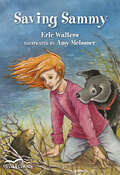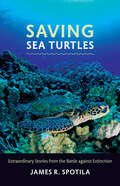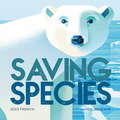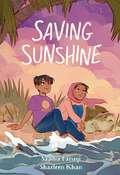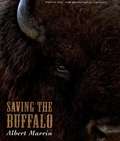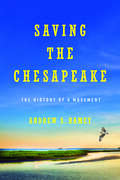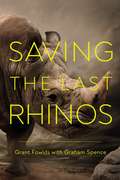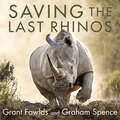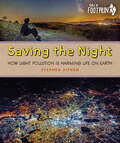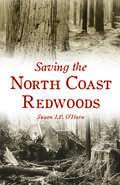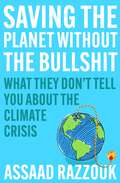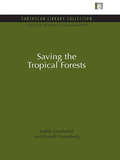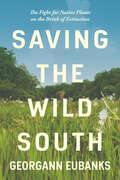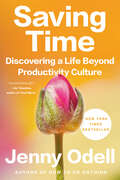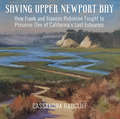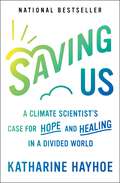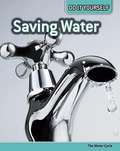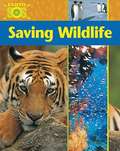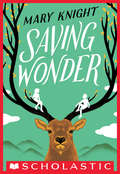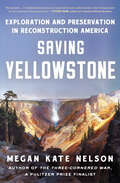- Table View
- List View
Saving Sammy (Orca Echoes)
by Eric WaltersAfter Morgan’s backyard is flooded by the nearby river, her dog, Shire, finds a baby beaver that has been washed out of its den. Realizing that its parents aren’t coming back, Morgan must quickly learn to care for the beaver, which she names Sammy. Morgan’s parents warn her that he can’t stay with them forever. Will Morgan be able to find a safe home for Sammy? The epub edition of this title is fully accessible.
Saving Sea Turtles: Extraordinary Stories from the Battle against Extinction
by James R. SpotilaIn April 2007, eleven leatherback turtles captured the imagination of the public worldwide as they "raced" from Costa Rica toward the Galápagos Islands. Known as the Great Turtle Race, this event tracked these critically endangered sea turtles, drawing attention to their fragile status and generating data on the turtles vital to efforts to study and protect them.But the Great Turtle Race is just one of many tools marine conservationists use to inform people about the status, biology, and lives of the seven sea turtle species. Due to human actions, once-plentiful sea turtle population levels plummeted throughout much of the twentieth century, stabilizing somewhat only after Archie Carr and Jacques Cousteau popularized their plight. With Saving Sea Turtles, award-winning author James R. Spotila picks up where Carr and Cousteau left off, going inside the modern-day conservation movement to tell the tales of today’s sea turtle conservationists. He provides a complete overview of sea turtle biology and life cycles, discusses the human and natural world threats they face, and examines the new methods and technologies humans are using to save them. Throughout, Spotila dots the narrative with stories of real-life heroes who risk life and limb to understand, track, and conserve sea turtles across the globe.Spotila has been at the forefront of sea turtle research and conservation for decades. His inspirational story of dedicated individuals, creative endeavors, and adventure reveals what is being done and what else we must do in order to ensure that these fascinating animals continue swimming in the oceans.
Saving Snakes: Snakes and the Evolution of a Field Naturalist
by Nicolette L. CagleBeautiful to behold and extremely sensitive to its environment, the snake is nonetheless stigmatized as a serpent, a creature that almost universally inspires fear. At a time when so many animals are endangered, who will speak up for the snake?Snake populations are declining precipitously around the globe, but calls for their conservation are muted by fear and prejudice. Saving Snakes offers a new approach to understanding snakes and preserving their populations—an approach built on respect. Nicolette Cagle has traveled the world in search of snakes, from the Midwest and the southeastern United States to Cuba, Nicaragua, and Australia, and spent decades conducting natural science research on the patterns of snakes in regions where urban development encroaches upon the natural world. Her book offers a firsthand account of the strange and secretive lives of snakes, and reveals their devastating losses.Beautifully and accessibly written, Saving Snakes entwines Cagle’s personal narrative with deep scientific and historical research. Through the author’s exploration of her evolution as a field naturalist, it provides a blueprint for developing a conservation consciousness among young people and paves the way for increased inclusivity in the male-dominated field of herpetology. While fundamentally a book about snakes, this is also the story of one woman's pursuit of her passion as she searches for, studies, and advocates up for these enigmatic creatures.
Saving Species
by Jess FrenchTigers, orangutans, pangolins, polar bears, fin whales, bees ... there are so many incredible animals that need saving! Join vet, conservationist and children's TV presenter Dr Jess French and take a trip around the world to meet 38 of the most extraordinary creatures on the planet. From the endangered animals we all know and love, like tigers, polar bears, orangutans and rhinos, to the less familiar pangolin, kakapo and vaquita, see these amazing creatures up close in their natural habitats. Visit jungles, mountains, rivers and coral reefs and learn about the threats to these species' survival, as well as the remarkable conservation efforts that are being undertaken to save them.Illustrated in a stunning graphic artwork style, this beautiful gift book is sure to inspire future conservationists and animal lovers of all ages.
Saving Sunshine
by Saadia FaruqiFrom Saadia Faruqi and Shazleen Khan comes a relatable, funny, and heart-wrenchingly honest graphic novel about Muslim American siblings who must learn how to stop fighting and support each other in a world that is often unkind.It's hard enough being a kid without being teased for a funny sounding name or wearing a hijab.It's even harder when you're constantly fighting your sibling—and Zara and Zeeshan really can't stand each other. During a family trip to Florida, when the bickering, shoving, and insults reach new heights of chaos, their parents sentence them to the worst possible fate— each other’s company! But when the twins find an ailing turtle, it presents a rare opportunity for teamwork—if the two can put their differences aside at last.
Saving Tarboo Creek: One Family’s Quest to Heal the Land
by Scott Freeman Susan Leopold Freeman“A moving account of a beautiful project. We need stories of healing in this tough moment; this is a particularly fine one.” —Bill McKibben, author of Radio Free Vermont When the Freeman family decided to restore a damaged creek in Washington’s Olympic Peninsula—to transform it from a drainage ditch into a stream that could again nurture salmon— they knew the task would be formidable and the rewards plentiful. In Saving Tarboo Creek, Scott Freeman artfully blends his family’s story with powerful universal lessons about how we can all live more constructive, fulfilling, and natural lives by engaging with the land rather than exploiting it. Equal parts heartfelt and empowering, this book explores how we can all make a difference one choice at a time. In the proud tradition of Aldo Leopold’s A Sand County Almanac, Saving Tarboo Creek is both a timely tribute to our land and a bold challenge to protect it.
Saving the Buffalo
by Albert Marrin"Saving the Buffalo" is the amazing story of how the buffalo reached the brink of extinction within a century and how it was saved.
Saving the Chesapeake: The History of a Movement
by Andrew S. RameyThe decades-long effort to protect one of the nation&’s most important waterways The Chesapeake Bay is the largest estuary in the United States and the site of some of the most significant moments in the nation&’s history. This book provides for the first time a comprehensive story of the effort to save and protect its waters and living resources for future generations. Andrew Ramey describes the enormous task—engaging the states in the Bay&’s watershed and the federal government since 1983—to realize one of the largest, most complex, and most expensive ecosystem restoration projects ever undertaken. He also unfolds a dramatic political narrative, tracing the momentous changes in American environmental politics from the &“green&” heyday of the 1960s and 1970s to the environmental movement&’s collision with the Reagan administration in the 1980s and the movement&’s ultimate triumph over the anti-environmental backlash of the 1990s and early 2000s. Along the way, he clarifies assumptions about the environmental movement, the major parties&’ roles in it, and our society&’s efforts to forge sustainable relationships with the natural world. Saving the Chesapeake reveals how a campaign to rescue this crucial resource altered the course of American environmentalism.
Saving the Last Rhinos: The Life Of A Frontline Conservationist
by Grant Fowlds Graham SpenceThe remarkable story of Grant Fowlds, who has dedicated his life to saving the imperiled rhinos, vividly told with Graham Spence, co-author of the bestselling The Elephant Whisperer.What would drive a man to &‘smuggle&’ rhino horn back into Africa at great risk to himself? This is just one of the situations Fowlds has put himself in as part of his ongoing fight against poaching, in order to prove a link between southern Africa and the illicit, lucrative trade in rhino horn in Vietnam. Shavings of rhino horn are sold as a snake-oil &“cures,&” but a rhino&’s horn has no magical, medicinal properties whatsoever. Yet it is for this that rhinoceroses are being killed at an escalating rate that puts the survival of the species in jeopardy. This corrupt, illegal war on wildlife has brought an iconic animal to the brink of extinction. Growing up on a farm in the eastern Cape of South Africa, Grant developed a deep love of nature, turning his back on hunting to focus on saving wildlife of all kinds and the environment that sustains both them and us. He is a passionate conservationist who puts himself on the front line of protecting rhinos in the wild—right now, against armed poachers—and in the long term, through his work with schoolchildren, communities, and policymakers.
Saving the Last Rhinos: The Life of a Frontline Conservationist
by Grant Fowlds Graham SpenceThe remarkable story of Grant Fowlds, a conservationist who has dedicated his life to saving the last rhinos, vividly told with the help of Graham Spence, co-author of the bestselling The Elephant Whisperer.'A terrific read . . . an outstanding book!'Gary Player and Vivienne Player'A truly heart-wrenching story, but a must-read for all who value our wild animals and their right to roam free. Grant Fowlds is a Zulu in a white skin and loves the people who hold the key to animal conservation. This is an intriguing true story that sends a clear message to the rest of the world.'Phil Liggett'Exceptionally readable - a fluid and captivating story . . . a swashbuckling tale.'Dr Dave Cooper, Rhinos Without Borders veterinarian, and Debbie Cooper of iSimangaliso Wetland Park'A rollicking true-life adventure that celebrates rhinos and people'Guy Rogers, Daily Herald'Truly awe-inspiring . . . Read this book. You will get a sense of Africa like never before, from a true African soul.'David S. Lee, Limbani in the blockbuster movie Black Panther'An excellent read . . . both sobering and uplifting'Moira Smith, General Manager Africa & Middle East, Goway TravelWhat would drive a man to 'smuggle' rhino horn back into Africa at great risk to himself? This is just one of the situations Grant Fowlds has put himself in as part of his ongoing fight against poaching, in order to prove a link between southern Africa and the illicit, lucrative trade in rhino horn in Vietnam.Shavings of rhino horn are sold as a snake-oil 'cure' for colds or impotence, but a rhino's horn has no magical, medicinal properties. It is for this that rhinoceroses are being killed at an escalating rate that puts the survival of the species in jeopardy. This corrupt, illegal war on wildlife has brought an iconic animal to the brink of extinction.Growing up on a farm in the Eastern Cape of South Africa, Grant developed a deep love of nature, turning his back on hunting to focus on saving wildlife of all kinds and the environment that sustains both them and us. He is a passionate conservationist who puts himself on the front line of protecting rhinos in the wild - right now, against armed poachers; but in the longer term, too, through his work with schoolchildren, communities and policymakers.We are most grateful to photographer Gerhard van der Westhuizen for the use of his stunning photograph on the cover of the book.
Saving the Last Rhinos: The Life of a Frontline Conservationist
by Grant Fowlds Graham Spence'A terrific read . . . an outstanding book!'Gary Player and Vivienne Player'A truly heart-wrenching story, but a must-read for all who value our wild animals and their right to roam free. Grant Fowlds is a Zulu in a white skin and loves the people who hold the key to animal conservation. This is an intriguing true story that sends a clear message to the rest of the world.'Phil Liggett'Exceptionally readable - a fluid and captivating story . . . a swashbuckling tale.'Dr Dave Cooper, Rhinos Without Borders veterinarian, and Debbie Cooper of iSimangaliso Wetland Park'A rollicking true-life adventure that celebrates rhinos and people'Guy Rogers, Daily Herald'Truly awe-inspiring . . . Read this book. You will get a sense of Africa like never before, from a true African soul.'David S. Lee, Limbani in the blockbuster movie Black Panther'An excellent read . . . both sobering and uplifting'Moira Smith, General Manager Africa & Middle East, Goway TravelWhat would drive a man to 'smuggle' rhino horn back into Africa at great risk to himself? This is just one of the situations Grant Fowlds has put himself in as part of his ongoing fight against poaching, in order to prove a link between southern Africa and the illicit, lucrative trade in rhino horn in Vietnam.Shavings of rhino horn are sold as a snake-oil 'cure' for colds or impotence, but a rhino's horn has no magical, medicinal properties. It is for this that rhinoceroses are being killed at an escalating rate that puts the survival of the species in jeopardy. This corrupt, illegal war on wildlife has brought an iconic animal to the brink of extinction.Growing up on a farm in the Eastern Cape of South Africa, Grant developed a deep love of nature, turning his back on hunting to focus on saving wildlife of all kinds and the environment that sustains both them and us. He is a passionate conservationist who puts himself on the front line of protecting rhinos in the wild - right now, against armed poachers; but in the longer term, too, through his work with schoolchildren, communities and policymakers.We are most grateful to photographer Gerhard van der Westhuizen for the use of his stunning photograph on the cover of the book.
Saving the Last Rhinos: The Life of a Frontline Conservationist
by Graham Spence Grant Fowlds'A terrific read . . . an outstanding book!'Gary Player and Vivienne Player'A truly heart-wrenching story, but a must-read for all who value our wild animals and their right to roam free. Grant Fowlds is a Zulu in a white skin and loves the people who hold the key to animal conservation. This is an intriguing true story that sends a clear message to the rest of the world.'Phil Liggett'Exceptionally readable - a fluid and captivating story . . . a swashbuckling tale.'Dr Dave Cooper, Rhinos Without Borders veterinarian, and Debbie Cooper of iSimangaliso Wetland Park'A rollicking true-life adventure that celebrates rhinos and people'Guy Rogers, Daily Herald'Truly awe-inspiring . . . Read this book. You will get a sense of Africa like never before, from a true African soul.'David S. Lee, Limbani in the blockbuster movie Black Panther'An excellent read . . . both sobering and uplifting'Moira Smith, General Manager Africa & Middle East, Goway TravelWhat would drive a man to 'smuggle' rhino horn back into Africa at great risk to himself? This is just one of the situations Grant Fowlds has put himself in as part of his ongoing fight against poaching, in order to prove a link between southern Africa and the illicit, lucrative trade in rhino horn in Vietnam.Shavings of rhino horn are sold as a snake-oil 'cure' for colds or impotence, but a rhino's horn has no magical, medicinal properties. It is for this that rhinoceroses are being killed at an escalating rate that puts the survival of the species in jeopardy. This corrupt, illegal war on wildlife has brought an iconic animal to the brink of extinction.Growing up on a farm in the Eastern Cape of South Africa, Grant developed a deep love of nature, turning his back on hunting to focus on saving wildlife of all kinds and the environment that sustains both them and us. He is a passionate conservationist who puts himself on the front line of protecting rhinos in the wild - right now, against armed poachers; but in the longer term, too, through his work with schoolchildren, communities and policymakers.We are most grateful to photographer Gerhard van der Westhuizen for the use of his stunning photograph on the cover of the book.
Saving the Night: How Light Pollution Is Harming Life on Earth (Orca Footprints #26)
by Stephen AitkenKey Selling Points Light pollution is threatening the survival of plants and animals all over the world and the ecosystems they depend on. For example, millions of migratory birds die every year because of light pollution. More than 80 percent of the world lives under skyglow from artificial lights. Two-thirds of the U.S. population and more than one-half of the European population can't see the Milky Way with the naked eye. The skyglow from Los Angeles can be seen by a plane 500 miles away. Light pollution and artificial lights like LEDs have a detrimental effect on human health and upsets our circadian rhythm. It has also been linked to some cancers. Plants and animals have adapted to live in darkness over millions of years. Darkness is as necessary as daylight for their survival. Stephen Aitken is a biologist and the author ofListen Up , also in the Orca Footprints series.
Saving the North Coast Redwoods (Brief History)
by Susan J.P. O'HaraThe battle to preserve a natural wonder.Towering and majestic, the redwood forests of California's North Coast once drew not visitors, but fortune-seeking timber companies. By 1917, the region had been logged for nearly 70 years and concerns arose that the rapidly disappearing redwoods could be lost. Damage wrought by logging and road construction caught the attention of Madison Grant, John Campbell Merriam, and Henry Fairfield Osborn and the Save the Redwoods League was born. Together with the State of California and the U.S. Federal Government, the League's efforts led to the protection of the remaining old growth redwoods, creating state and national parks to preserve them for future generations.Author Susan J.P. O'Hara recounts the story of the fight to save the world's tallest trees.
Saving the Planet Without the Bullshit: What They Don't Tell You About the Climate Crisis
by Assaad RazzoukHave you heard that you should go vegan to save the planet? Or carbon offset your flight to mitigate its effects? Or invest in an ethical pension plan? What if you were told that such actions make little difference at all? In Saving the Planet Without the Bullshit, Assaad argues that for too long green activism has been unfocused and distracted, trying to go in too many directions, focussing on individual behaviour. But all these things, are dwarfed by the one big thing that simply has to happen, very soon: namely, massively curtailing the activities of the hydrocarbon and petrochemicals industry. Full of counter-intuitive statistics and positive suggestions for individual and collective action, this ingenious book will profoundly change how you view the climate crisis.
Saving the Seed: Genetic diversity and European agriculture (Natural Resource Management Set)
by Renee VellveGenetic diversity is essential to the security of agriculture. Without the availability of a wide range of plant varieties and the genetic resources they contain, crops cannot adapt to combat the ever-changing threats of pests, diseases and climatic change. Yet, with the increasing industrialisation of modern agriculture, farming has become a business which centres on a handful of new, genetically similar 'super seeds'. Plants must evolve in order to survive, but modern agriculture has replaced diversity with uniformity, and security with vulnerability. Saving the Seed traces the decline of crop varieties in European farming and describes what is being done to safeguard genetic resources for the future. Conservation efforts by government and industry suffer from serious drawbacks, with wrangles over ownership and control of resources. The crucial work is being done by individuals and grassroots organisations, who largely go unrecognised and under-resourced. What is urgently needed are sound policies to promote the diversification of agriculture and an integrated strategy for safeguarding the genetic base of our food system. Saving the Seed contains the most up-to-date information available on genetic resources in Europe and on those working to save them. Renee Vellve is a researcher at GRAIN, a no-governmental organisation working to promote the sustainable conservation and use of genetic diversity, based on grassroots approaches to genetic resources management. Originally published in 1992
Saving the Tropical Forests (Natural Resource Management Set)
by Judith Gradwohl Russell GreenbergThe destruction of the tropical forest is one of the major problems of our time. Vast areas are rapidly becoming wastelands which support only a few tough weeds, perhaps some cattle, and the farms allowed to the poor. This book provides a vision of hope: in Latin America. Africa. And South East Asia, growing numbers of people are developing techniques specifically designed to promote the wise use and preservation of remaining forest lands. However, these grassroots strategies are often ignored in favour of grandiose schemes which inevitably fail. This pattern must be broken now or the tropical forests will be lost forever. Published in association with the Smithsonian Institution. Preface by Michael Robinson, Director, National Zoological Park. Smithsonian Institution Originally published in 1988
Saving the Wild South: The Fight for Native Plants on the Brink of Extinction
by Georgann EubanksThe American South is famous for its astonishingly rich biodiversity. In this book, Georgann Eubanks takes a wondrous trek from Alabama to North Carolina to search out native plants that are endangered and wavering on the edge of erasure. Even as she reveals the intricate beauty and biology of the South's plant life, she also shows how local development and global climate change are threatening many species, some of which have been graduated to the federal list of endangered species.Why should we care, Eubanks asks, about North Carolina's Yadkin River goldenrod, found only in one place on earth? Or the Alabama canebrake pitcher plant, a carnivorous marvel being decimated by criminal poaching and a booming black market? These plants, she argues, are important not only to the natural environment but also to southern identity, and she finds her inspiration in talking with the heroes—the botanists, advocates, and conservationists young and old—on a quest to save these green gifts of the South for future generations. These passionate plant lovers caution all of us not to take for granted the sensitive ecosystems that contribute to the region's long-standing appeal, beauty, and character.
Saving Time: Discovering a Life Beyond the Clock
by Jenny OdellWe are living on the wrong clock, and it is destroying us. The New York Times bestselling author of How to Do Nothing offers us different ways to experience time in this dazzling, subversive, and deeply hopeful book. <p><p>In her first book, How to Do Nothing, Jenny Odell wrote about the importance of disconnecting from the “attention economy” to spend time in quiet contemplation. But what if you don’t have time to spend? <p><p>In order to answer this seemingly simple question, Odell took a deep dive into the fundamental structure of our society and found that the clock we live by was built for profit, not people. This is why our lives, even in leisure, have come to seem like a series of moments to be bought, sold, and processed ever more efficiently. Odell shows us how our painful relationship to time is inextricably connected not only to persisting social inequities but to the climate crisis, existential dread, and a lethal fatalism. <p><p>This dazzling, subversive, and deeply hopeful book offers us different ways to experience time—inspired by pre-industrial cultures, ecological cues, and geological timescales—that can bring within reach a more humane, responsive way of living. As planet-bound animals, we live inside shortening and lengthening days alongside gardens growing, birds migrating, and cliffs eroding; the stretchy quality of waiting and desire; the way the present may suddenly feel marbled with childhood memory; the slow but sure procession of a pregnancy; the time it takes to heal from injuries. Odell urges us to become stewards of these different rhythms of life in which time is not reducible to standardized units and instead forms the very medium of possibility. <p><p>Saving Time tugs at the seams of reality as we know it—the way we experience time itself—and rearranges it, imagining a world not centered on work, the office clock, or the profit motive. If we can “save” time by imagining a life, identity, and source of meaning outside these things, time might also save us. <p> <b>New York Times Bestseller</b>
Saving Upper Newport Bay: How Frank and Frances Robinson Fought to Preserve One of California's Last Estuaries
by Cassandra RadcliffDuring Orange County's population boom in the early 1960s, the Robinson family moved to Newport Beach. A short walk from their home was Upper Newport Bay, where they and their neighbors could play on North Star Beach, water ski on the bay's calm water, or dig in the shallow mudflats for fresh clams for dinner. But land developers and local government officials had a different use for the open space in mind—build a private harbor much like the bustling lower Newport Bay and Balboa Island. In 1963, 14-year-old Jay Robinson rode his bike down to North Star Beach and found a newly erected “private property” sign. His parents, Frank and Frances Robinson, would soon find themselves embroiled in one of the most important ecological battles in California, with friends, neighbors, newspapers, the government, and the courts all taking sides. Saving Upper Newport Bay is the story of two ordinary people's life-changing journey, which ultimately impacted the history and ecology of southern California. This book was produced on the 50th anniversary of The Newport Bay Conservancy, which focuses exclusively on the conservation and restoration of Upper Newport Bay. Included are full color photos depicting the history of the bay.
Saving Us: A Climate Scientist's Case for Hope and Healing in a Divided World
by Katharine HayhoeUnited Nations Champion of the Earth, climate scientist, and evangelical Christian Katharine Hayhoe changes the debate on how we can save our future in this nationally bestselling &“optimistic view on why collective action is still possible—and how it can be realized&” (The New York Times).Called &“one of the nation&’s most effective communicators on climate change&” by The New York Times, Katharine Hayhoe knows how to navigate all sides of the conversation on our changing planet. A Canadian climate scientist living in Texas, she negotiates distrust of data, indifference to imminent threats, and resistance to proposed solutions with ease. Over the past fifteen years Hayhoe has found that the most important thing we can do to address climate change is talk about it—and she wants to teach you how. In Saving Us, Hayhoe argues that when it comes to changing hearts and minds, facts are only one part of the equation. We need to find shared values in order to connect our unique identities to collective action. This is not another doomsday narrative about a planet on fire. It is a multilayered look at science, faith, and human psychology, from an icon in her field—recently named chief scientist at The Nature Conservancy. Drawing on interdisciplinary research and personal stories, Hayhoe shows that small conversations can have astonishing results. Saving Us leaves us with the tools to open a dialogue with your loved ones about how we all can play a role in pushing forward for change.
Saving Water: The Water Cycle
by Buffy SilvermanHow much water should you drink in a day? Where does rain go? How does water shape the land? Do It Yourself offers an exciting new approach to understanding and investigation. Each book helps you to conduct your own experiments and activities, and to learn more about the world around us.
Saving Wildlife (Earth SOS)
by Sally MorganOffering information at multiple levels for several reading levels, this series describes the many dimensions of wildlife depletion and its related problems that accompany global warming and mankind's abuse of the environment. The interdependence of all the natural systems in the world are stressed in the book. This volume concludes with a fact file and suggestions for the reader on how to improve the environment.
Saving Wonder (Scholastic Press Novels)
by Mary KnightIn this utterly transporting debut about the power of words, the importance of friendship, and the magic of wonder, Curly Hines must decide whether to fight to save the mountain he calls home.Having lost most of his family to coal mining accidents as a little boy, Curley Hines lives with his grandfather in the Appalachian Mountains of Wonder Gap, Kentucky. Ever since Curley can remember, Papaw has been giving him a word each week to learn and live. Papaw says words are Curley's way out of the holler, even though Curley has no intention of ever leaving.When a new coal boss takes over the local mining company, life as Curley knows it is turned upside down. Suddenly, his best friend, Jules, is interested in the coal boss's son, and worse, the mining company threatens to destroy Curley and Papaw's mountain. Now Curley faces a difficult choice. Does he use his words to speak out against Big Coal and save his mountain, or does he remain silent and save his way of life?From debut author Mary Knight comes a rich, lyrical, and utterly transporting tale about friendship, the power of words, and the difficult hurdles we must overcome for the people and places we love.
Saving Yellowstone: Exploration and Preservation in Reconstruction America
by Megan Kate NelsonFrom historian and critically acclaimed author of The Three-Cornered War comes the propulsive and vividly told story of how Yellowstone became the world&’s first national park amid the nationwide turmoil and racial violence of the Reconstruction era.Each year nearly four million people visit Yellowstone National Park—one of the most popular of all national parks—but few know the fascinating and complex historical context in which it was established. In late July 1871, the geologist-explorer Ferdinand Hayden led a team of scientists through a narrow canyon into Yellowstone Basin, entering one of the last unmapped places in the country. The survey&’s discoveries led to the passage of the Yellowstone Act in 1872, which created the first national park in the world. Now, author Megan Kate Nelson examines the larger context of this American moment, illuminating Hayden&’s survey as a national project meant to give Americans a sense of achievement and unity in the wake of a destructive civil war. Saving Yellowstone follows Hayden and two other protagonists in pursuit of their own agendas: Sitting Bull, a Lakota leader who asserted his peoples&’ claim to their homelands, and financier Jay Cooke, who wanted to secure his national reputation by building the Northern Pacific Railroad through the Great Northwest. Hayden, Cooke, and Sitting Bull staked their claims to Yellowstone at a critical moment in Reconstruction, when the Grant Administration and the 42nd Congress were testing the reach and the purpose of federal power across the nation. A narrative of adventure and exploration, Saving Yellowstone is also a story of Indigenous resistance, the expansive reach of railroad, photographic, and publishing technologies, and the struggles of Black southerners to bring racial terrorists to justice. It reveals how the early 1870s were a turning point in the nation&’s history, as white Americans ultimately abandoned the the higher ideal of equality for all people, creating a much more fragile and divided United States.
